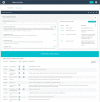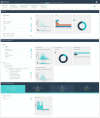PlatformTM, a standards-based data custodianship platform for translational medicine research
- PMID: 31409798
- PMCID: PMC6692384
- DOI: 10.1038/s41597-019-0156-9
PlatformTM, a standards-based data custodianship platform for translational medicine research
Abstract
Biomedical informatics has traditionally adopted a linear view of the informatics process (collect, store and analyse) in translational medicine (TM) studies; focusing primarily on the challenges in data integration and analysis. However, a data management challenge presents itself with the new lifecycle view of data emphasized by the recent calls for data re-use, long term data preservation, and data sharing. There is currently a lack of dedicated infrastructure focused on the 'manageability' of the data lifecycle in TM research between data collection and analysis. Current community efforts towards establishing a culture for open science prompt the creation of a data custodianship environment for management of TM data assets to support data reuse and reproducibility of research results. Here we present the development of a lifecycle-based methodology to create a metadata management framework based on community driven standards for standardisation, consolidation and integration of TM research data. Based on this framework, we also present the development of a new platform (PlatformTM) focused on managing the lifecycle for translational research data assets.
Conflict of interest statement
The authors declare no competing interests.
Figures








References
-
- Skolariki, K. & Avramouli, A. In GeNeDis 2016988, 301–311 (Springer International Publishing, 2017). - PubMed
Publication types
MeSH terms
Grants and funding
- BB/I000771/1/BB_/Biotechnology and Biological Sciences Research Council/United Kingdom
- 115446 & 115308/Innovative Medicines Initiative (IMI)/International
- BB/E025080/1/BB_/Biotechnology and Biological Sciences Research Council/United Kingdom
- 115446/Innovative Medicines Initiative (IMI)/International
- 115308/Innovative Medicines Initiative (IMI)/International

